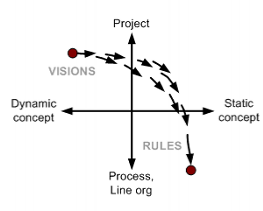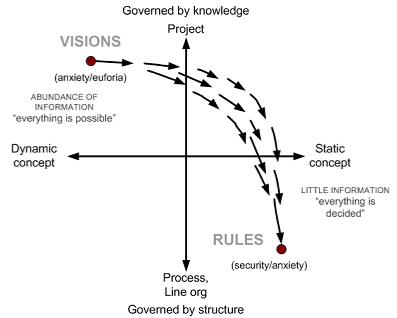Many companies struggle with product development in the line organization, or have their developers participate in several projects simultaneously - both equally problematic.
Dynamic concepts are made static by finding solutions and deciding how functions shall be realized. It is like making a sculpture out of a block of marble, which in itself contains an unlimited number of possibilities. You remove marble, thereby reducing the number of possibilities by every chip until eventually the desired statue have been created. This is from an information technology point of view equivalent to substantially reduce information.
We understand that as we move nearer to the finished product a number of risks have disappeared - it is becoming ever more probable that we shall succeed. The closer we get to the finish, the more uncertainty is reduced in the project.
The goal is to determine in minute detail what the new product shall look like (geometry, material, tolerances, surface treatment, color, scent, etc), manufacturing, logistics and the design of package material, as well as manuals and sales promotions, etc.
When this unique description is in place and implemented in the company processes, in the line organization, then product development is finished in the way that now production and sales of the new product take over and drive the product business. Especially the production process is very static where every produced detail must be identical to every other detail of the same sort.
Concepts are now static and the line organization, so governed by structure, by rules and regulations, has taken over the product from the visions- and knowledge governed project.
All humans differ. Some of us are happy in the free environment at the beginning of a development project, while others become anxious faced with all uncertainty. They crave rigid rules and routines and find security in the rules and structure of the line organization, where instead the project minded and entrepreneurial personalities feel anxiety or become bored.
We have in product development to opposites. And this is unfortunate. There are group psychologists that say that anxiety reduction is the single most important factor for understanding human behavior. Unfortunately the very group norms that are anxiety reducing may also be detrimental to efficiency and work performance, and vice versa.











